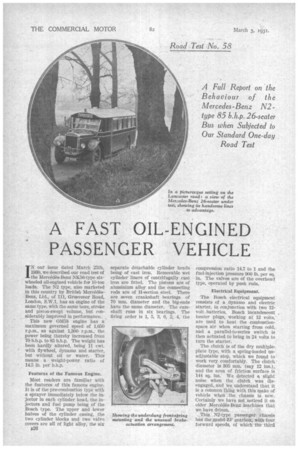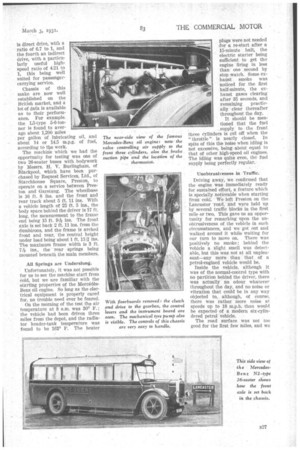A FAST OIL-ENGINED PASSENGER VEHICLE
Page 44

Page 45

Page 46

If you've noticed an error in this article please click here to report it so we can fix it.
IN our issue dated March 25th, 1930, we described our road test of the Me/Wiles-Benz NK56-type six' wheeled oil-engined vehicle fop 10-ton loads.. The N2 type, also marketed in this country by British Merce0sBenz, Ltd., of 111, Grosvenor Road, London, S.W.1, has an engine of the same type, with the same bore, stroke and piston-swept volume,. but con „ siderably improved in performance. .
This new 0M58 engine has a maximum governed speed of 1,650 r.p.m., as against 1,300 r.p.m., the power being thereby increased from 70 b.h.p. to 85 b.h.p. The weight has been hardly altered, being 11 cwt.
' with flywheel, dynamo and starter, but without oil or water. This . means a weight-power ratio of ' 14.5.1b. per b.h.p.
Features of the Famous Engine.
Most readers are familiar with the features of this famous engine. It is of the pre-combustion type with a sprayer immediately below the injector in each cylinder head, the injectors and fuel pump being of the Bosch type. The upper and lower halves of the cylinder casing, the two cylinder blocks and two valve covers are all of light alloy, the six B26 . separate detachable cylinder heads being of east iron. Removable wet cylinder liners of centrifugally cast iron are fitted. The pistons are of aluminium alloy and the connecting rods are of H-section steel. There are seven crankshaft bearings of 70 mm. diameter and the big-ends have the same diameter. The camshaft runs in six bearings. The firing order is 1, 5, 3, 6, 2, 4, the compression ratio 14.7 to 1 and the fuel-injection pressure 900 lb. per sq. in. The valves are of the overhead type, operated by push rods.
Electrical Equipment.
The Bosch electrical equipment consists of a dynamo and electric starter, in conjunction with two 12volt batteries. Bosch incandescent . heater plugs, Working at 12 volts, are used to heat the combustionspace air when starting from cold, and a parallel-to-series switch is then actuated to bring in 24 volts to turn the starter.
The clutch is of the dry multipleplate type, with a spring-loaded unadjustable stop, which we found to work very comfortably. The clutch . diameter is 305 ram. (say 12 ins.), and the area of friction surface is 144 sq. ins. We detected a slight noise when the clutch was , disengaged, ,and we understand that it is a Common thing With this make of vehicle when the chassis is new. Certainly we have not. noticed it on older Me_rced6s-Benz Machines that we have driven.
This N2-type passenger chassis has the'rnodel-ZF gearbox; with four forward speeds, of which the third is direct drive, with a ratio of 6.7 to 1, and the fourth an indirect drive, with a particularly useful highspeed ratio of 4.21 to 1, this being well suited for passengercarrying service.
Chassis of this make are now well established on the British market, and a lot of data is available as to their performance. For example. the L5-type 5-6-tonner is found to average about 1,200 miles per gallon of _lubricating oil, about 14 or 14.5 m.p.g. of according to the work. The machine which we had the opportunity for testing was one of two 26-seater buses with bodywork by Messrs. H. V. Burlingham, of Blackpool, which have been purchased by Request Services, Ltd., of Starchhouse Square, Preston, to operate on a service between Preston and Garstang. The wheelbase is 16 ft. 8 ins, and the front and rear track about 5 ft. 11 ins. With a vehicle length of 25 ft. 5 ins., the body space behind the driver is 17 ft. long, the measurement to the frame end being 15 ft. 9-126ins. The front axle is set back 2 ft. 11 ins, from the dumbirons, and the frame is arched front and rear, the central height under load being about 1 ft. 11-1-1ins. The maximum frame width is 3 ft. 7,54. ins., the rear springs being mounted beneath the main members. and fuel, All Springs are Underslung.
Unfortunately, it was not possible for us to see the machine start from old, but we are familiar with the starting properties of the MerOdesBenz oil engine. So long as the electrical equipment is properly cared for, no trouble need ever be feared.
On the morning of the test the air temperature at 8 a.m. was 30° F.; the vehicle had been driven three miles from the depot, and the radiator header-tank temperature was found to be 163° F. The heater With floorboards removed : the clutch and drive to the gearbox, the control levers and the instrument board are seen. The mechanical tyre pump also is visible. The controls of this chassis
are very easy to handle.
plugs'were not needed for a re-start after a 15-minute halt, the electric starter being sufficient to get the engine firing in less than one second by stop .watch. Some exhaust smoke was noticed for the first half-minute, the ex, haust gases clearing after 35 seconds, and remaining practically clear thereafter throughout the day.
It should be mentioned that the fuel supply to the front three Cylinders is eut off when the "throttle" is nearly closed. In spite of this the noise when idling is not excessive, being about equal to that of other high-speed oil engines. The idliUg was quite even, the fuel supply being perfectly regular.
Unobtrusiveness in Traffic.
Driving away, we confirmed that the engine was immediately ready for sustained effort, a feature which is specially noticeable when starting from' cold. We left Preston on the Lancaster -road, and were held up by several traffic blocks in the first mile or two. This gave us an opportunity for remarking upon the unobtrusiveness of the vehicle in such circumstances, and we got out and walked around it while waiting for our turn to move on. There was positively no smoke ; behind the vehicle a slight smell was detectable, but this was not at all unpleasant—any more than that of a petrol-engined vehicle would be.
Inside the vehicle, although it was of the normal-control type with no partition behind the driver, there was actually no odour whatever throughout the day, and no noise or vibration that could be in any way objected to, although, of course, there was rather more noise at speeds up to 18 m.p.h. than would be expected of a modern six-cylindered petrol vehicle.
The road surface was not too good for the first few miles, and we were well satisfied with the suspension. To represent the weight of 26 passengers, we had arranged iron weights approximately in the positions where the passengers would sit. It may be mentioned that the rear springs are 4 ft. 11 ins. long (shackled at both ends), the front springs being 3 ft. 8 ins. long.
Out on the open road we discovered that, utilizing the indirect top gear, this vehicle, weighing gross nearly 8 tons, was capable of speeds of 45-50 m.p.h. It is thought to be the fastest standard-production oil-engined coach or bus in the world. Control was perfectly easy at all speeds, gears and brakes being conveniently managed. Cruising at high average speeds on top gear is delightful for the driver, and the sustained power when climbing at about 40 m.p.h. is most satisfying.
We took an early opportunity for testing the speedometer, which, incidentally, reads up to only 40 m.p.h., B28
and we found that it was practically. accurate, for speed and distance, at all speeds. The slowest comfortable speed on fourth gear is 7 m.p.h., the engine in such circumstances pulling very much like a steam engine.
The steering, which is of the worm-and-nut type, is light and practically irreversible. We noticed that the turning circles were slightly big, this being due to the fact that the chassis, which was practically new, having covered only 300 miles on the road, had not been adjusted in this respect.
The braking arrangement is most interesting, the brake pedal has a small button, the depression of which, in the first stage of brake application, turns a butterfly valve in the air induction manifold (at the same time as the fuel supply is cut off from the front thfee cylinders), and the negative pressure created in the forward half of the manifold acts upon the BoschDewaiidre vacuum cylinder, giving quick and powerful action. It was found that either foot or hand brake would pull the vehicle tip and hold it on a gradient of 1 in 8. A graph reproduced herewith explains the braking performance, but the read,ings could no doubt have been improved upon had the road surface been dry.
The acceleration graph shows the steadiness of the engine power at various speeds, the acceleration from rest in third gear affording rather an interesting curve in this respect.
Apart from several untimed hillclimbs en route, we made a timed ascent of the East Road Hill, leading from Lancaster Town Hall up to the County Asylum. The length of the hill is 0.6 mile and, according to our aneroid, the ascent is about 210 ft. There was some ice on the road, the surface of which was otherwise good. On the steepest section, which had a gradient of about 1 in 8, first gear was required and a
steady 7.5 m.p.h. was maintained, which, considering the load, is very good. Second gear was engaged as the gradient eased off, the speed at the crest being about 17 m.p.h. The time was 3 mins. 7 secs., the speed, therefore, averaging 11.55 m.p.h.
Readings taken before and immediately after the climb showed that the cooling-water temperature rose frOm 164° to 176° F., this being the only departure from the neighbourhood of 163° during the whole day.
In view of the obvious suitability of this chassis for long-distance coach work, we decided to make two kinds of fuel-consumption test. The first was carried out on the Garstang-Preston road, on which this vehicle would fulfil its regular duty. We therefore drove the bus as if it were picking up and setting down passengers, making 17 stops in the course of 7 miles ; thus we averaged 12 m.p.h. and 10.66 m.p.g. Repeating the test, we made 17 stops in 6.3 miles, with only two uses of the indirect fourth gear, at the higher average speed of 17.2 m.p.h., and obtained a reading of 11.2 m.p.g. The second test was probably the more accurate, as we actually followed one of the Ribble Co.'s buses, stopping whenever it stopped. The average of the two tests gives a fuel consumption at the rate of 10.93 m.p.g.
Our other consumption test was on the basis of fast travel, and we covered 8.2 miles on half a gallon of fuel in 18 minutes, averaging 27.3 m.p.h. and 16.4 m.p.g. The two readings are themselves good evidence of the suitability of this chassis for long-distance coach service at high average speeds. Fourth gear was used to a large extent, and the bus was quiet and comfortable.




































































































